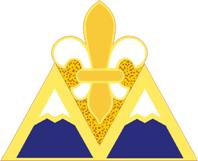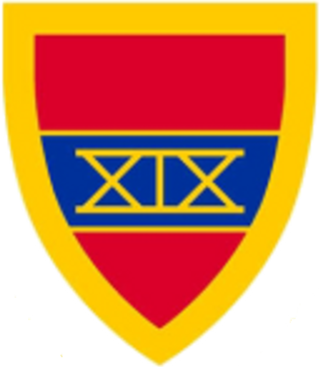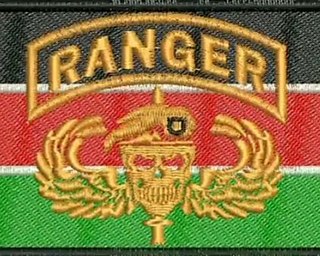Related Research Articles

The Kenya Defence Forces (KDF) are the armed forces of the Republic of Kenya. They are made up of the Kenya Army, Kenya Navy, and Kenya Air Force. The current KDF was established, and its composition stipulated, in Article 241 of the 2010 Constitution of Kenya; it is governed by the KDF Act of 2012. Its main mission is the defence and protection of the sovereignty and territorial integrity of Kenya, recruitment to the KDF is done on yearly basis. The President of Kenya is the commander-in-chief of the KDF, and the Chief of Defence Forces is the highest-ranking military officer, and the principal military adviser to the President of Kenya.

The 1st Infantry Division (1ID) is a combined arms division of the United States Army, and is the oldest continuously serving division in the Regular Army. It has seen continuous service since its organization in 1917 during World War I. It was officially nicknamed "The Big Red One" after its shoulder patch and is also nicknamed "The Fighting First." The division has also received troop monikers of "The Big Dead One" and "The Bloody First" as puns on the respective officially sanctioned nicknames. It is currently based at Fort Riley, Kansas.

The 1st Cavalry Division is a combined arms division and is one of the most decorated combat divisions of the United States Army. It is based at Fort Cavazos, Texas. It was formed in 1921 and served during World War II, the Korean War, the Vietnam War, the Persian Gulf War, with the Stabilization Force in Bosnia-Herzegovina, in the Iraq War, in the War in Afghanistan as well as Operation Freedom's Sentinel and Operation Inherent Resolve. As of July 2023, the 1st Cavalry Division is subordinate to III Armored Corps and is commanded by Major General Kevin D. Admiral.

The brigade combat team (BCT) is the basic deployable unit of maneuver in the U.S. Army. A brigade combat team consists of one combat arms branch maneuver brigade, and its assigned support and fire units. A brigade is normally commanded by a colonel (O-6) although in some cases a brigadier general (O-7) may assume command. A brigade combat team contains combat support and combat service support units necessary to sustain its operations. BCTs contain organic artillery training and support, received from the parent division artillery (DIVARTY). There are three types of brigade combat teams: infantry, Stryker, and armored.

The 172nd Infantry Brigade was a light infantry brigade of the United States Army stationed at Fort Wainwright, Alaska and later moved its headquarters to Grafenwöhr, Germany. An active duty independent brigade, it was part of V Corps and was one of five active-duty, separate, brigade combat teams in the U.S. Army before its most recent inactivation on 31 May 2013.

The Georgia Army National Guard is the Army National Guard component of the Georgia National Guard, administratively part of the Georgia Department of Defense. It consists of more than 11,100 citizen-soldiers training in more than 79 hometown armories and regional facilities across the state. Georgia’s Army Guard is the sixth largest in the nation and includes combat, combat support and combat service support units.

The Ohio Army National Guard is a part of the Ohio National Guard and the Army National Guard of the United States Army. It is also a component of the organized militia of the state of Ohio, which also includes the Ohio Naval Militia, the Ohio Military Reserve and the Ohio Air National Guard. The Ohio Army National Guard consists of a variety of combat, combat support, and combat service support units. As of September 2010, its end strength exceeded 11,400 soldiers. Its headquarters is the Beightler Armory in Columbus, Ohio. Many units conduct Annual Training at Camp Grayling, Michigan.

The Montana Army National Guard is a component of the United States Army and the United States National Guard. Nationwide, the Army National Guard comprises approximately one half of the US Army's available combat forces and approximately one third of its support organization. National coordination of various state National Guard units are maintained through the National Guard Bureau.

The 3rd Brigade Combat Team, 1st Cavalry Division is a combined arms armored brigade of the 1st Cavalry Division based in Fort Cavazos, TX. Major equipment includes the M1A2SEP Tanks, M2A3 & M3A3 Bradley infantry fighting vehicles, M109A7 Paladin howitzers, and M1114 up-armored Humvees.
The 2nd Combat Engineer Regiment (2 CER) is an Australian Army combat engineer regiment located at Gallipoli Barracks in Brisbane, Queensland. It is part of the Australian 7th Brigade, attached to Forces Command (Australia).

The 864th Engineer Battalion is a combat engineer battalion of the United States Army based at Joint Base Lewis-McChord, Washington. The battalion is a subordinate unit of 555th Engineer Brigade.

East Africa Command was a Command of the British Army. Until 1947 it was under the direct control of the Army Council and thereafter it became the responsibility of Middle East Command. It was disbanded on 11 December 1963, the day before Kenya became independent, and replaced by British Land Forces Kenya, tasked with withdrawing all remaining British troops. All remaining troops left by December 1964 and British Land Forces Kenya was disestablished.

The Kenya Army is the land arm of the Kenya Defence Forces.

The units of the Kenya Army Infantry are the principal fighting arms of the Kenya Army. The primary mission of the Infantry formations is to fight and win land battles within area of operational responsibilities in the defence of the nation against land – based aggression, while the secondary mission is the provision of aid and support to civil authorities in the maintenance of order. The Kenyan School of Infantry (SOI) is located in Isiolo County.

The Umkhonto Field Engineer Regiment is a regiment of the South African Army Engineer Formation. The unit is based in Durban with the HQ being at Old Fort Military Base, Lord's Grounds. As a reserve unit, it has a status roughly equivalent to that of a British Army Reserve or United States Army National Guard unit.

The British Army Training Unit Kenya (BATUK) is a training support unit of the British Army located in Kenya.

The Kenya Special Forces are units tasked with special operations found within the three branches of the Kenya Defence Forces and are under Special Forces Operations Command. The Army has the largest number of these units under the Army Special Operations Brigade (Kenya) containing the 20th Parachute Battalion (20th Paras), 30th Special Forces Battalion (30 SF) and 40th Ranger Strike Force (40 RSF). The Air Force has a Rapid Deployment Squadron (RDS) tasked with retrieving airmen behind enemy lines and it is the most recent addition to Kenya's specialized military units. The Navy has two units under its Special Operations Squadron which are the Clearance Diving Unit (CDU) and the main Special Boat Unit (SBU) formed with American assistance in the mid 2000s. The Special Operations Training School (SOTS) in Gilgil, Naivasha serves as the premier training establishment for all potential special forces operators. Kenyan special forces have been deployed in Southern Somalia, the Frontier counties of Mandera, Wajir and Garissa on the border with Somalia, Boni Forest near the Somali border and Eastern DRC

The Army Special Operations Brigade is a special forces unit of the Kenyan Army, tasked with airborne operations, commando raids, reconnaissance, counter-insurgency, infiltration and other specialized forms of warfare.
This is the Kenya Army formation dedicated towards providing artillery support to infantry and mechanized units in the army.
The Kenya Army Armoured Brigade is the formation tasked with conducting operations against enemy armour and providing close support to infantry units in military operations.
References
- ↑ "EASF Conducts Training at Army School of Combat Engineers". Easfcom.org. Retrieved 2021-11-14.
- ↑ "Kenya Army Engineers Brigade Combat Smuggling Ring & Militia Along Border with Ethiopia – Strategic Intelligence Service".
- ↑ "Kenya Completes Border Fence With Somalia - allAfrica.com". Archived from the original on 2016-12-06.
- ↑ John Pike. "Kenya Army History". Globalsecurity.org. Retrieved 2021-11-14.